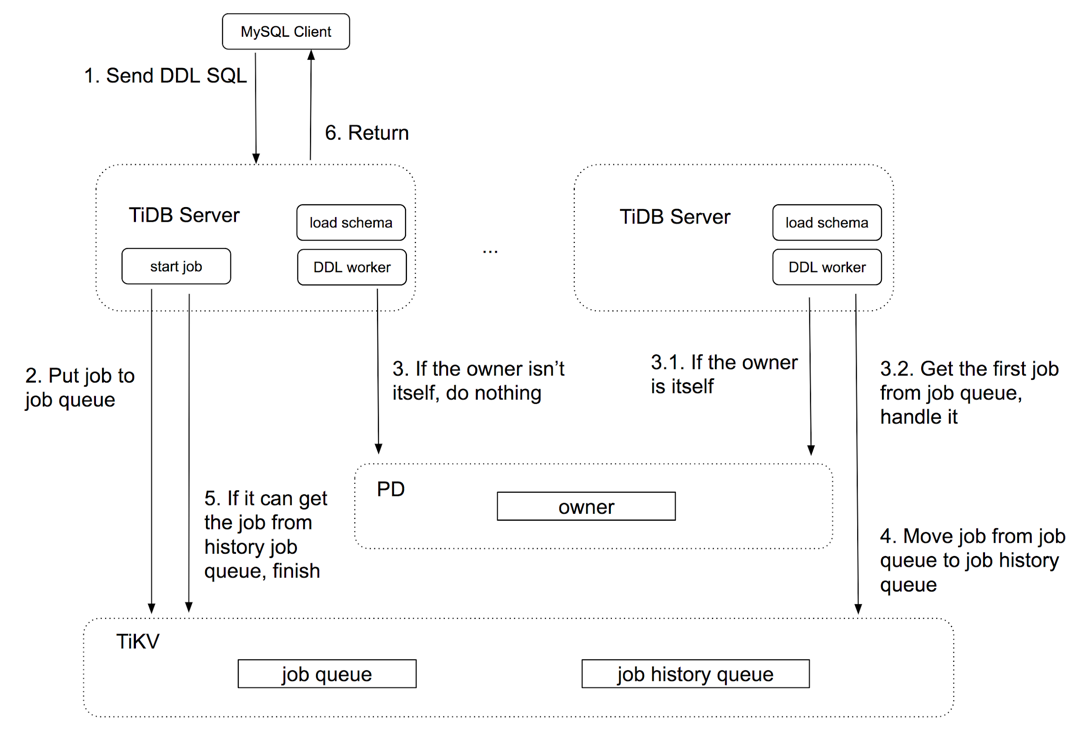DDL
本文主要描述TiDB在分布式场景下支持无锁schema变更。
Schema 信息会存储在TiKV中,每个TiDB server内存中也会有个Schema信息。
Schema
Schema in TiKV
Schema在kv中的存储形式如下
//meta/meta.go // Meta structure:
// NextGlobalID -> int64
// SchemaVersion -> int64
// DBs -> {
// DB:1 -> db meta data []byte
// DB:2 -> db meta data []byte
// }
// DB:1 -> {
// Table:1 -> table meta data []byte
// Table:2 -> table meta data []byte
// TID:1 -> int64
// TID:2 -> int64
// }
//
TiDB meta/meta.go模块封装了对存储在TiKV中schema进行的操作,在ddl owner节点在
runDDLJobs时候,会调用meta的方法, 来修改schema。
TiDB loadSchemaInLoop 中也会用到meta方法来加载schema.
模块层次之间调用如下图所示:
// Meta is for handling meta information in a transaction.
type Meta struct {
txn *structure.TxStructure
StartTS uint64 // StartTS is the txn's start TS.
jobListKey JobListKeyType
}
// TxStructure supports some simple data structures like string, hash, list, etc... and
// you can use these in a transaction.
type TxStructure struct {
reader kv.Retriever
readWriter kv.RetrieverMutator
prefix []byte
}
// RetrieverMutator is the interface that groups Retriever and Mutator interfaces.
type RetrieverMutator interface {
Retriever
Mutator
}
// Getter is the interface for the Get method.
type Getter interface {
// Get gets the value for key k from kv store.
// If corresponding kv pair does not exist, it returns nil and ErrNotExist.
Get(ctx context.Context, k Key) ([]byte, error)
}
// Retriever is the interface wraps the basic Get and Seek methods.
type Retriever interface {
Getter
// Iter creates an Iterator positioned on the first entry that k <= entry's key.
// If such entry is not found, it returns an invalid Iterator with no error.
// It yields only keys that < upperBound. If upperBound is nil, it means the upperBound is unbounded.
// The Iterator must be Closed after use.
Iter(k Key, upperBound Key) (Iterator, error)
// IterReverse creates a reversed Iterator positioned on the first entry which key is less than k.
// The returned iterator will iterate from greater key to smaller key.
// If k is nil, the returned iterator will be positioned at the last key.
// TODO: Add lower bound limit
IterReverse(k Key) (Iterator, error)
}
// Mutator is the interface wraps the basic Set and Delete methods.
type Mutator interface {
// Set sets the value for key k as v into kv store.
// v must NOT be nil or empty, otherwise it returns ErrCannotSetNilValue.
Set(k Key, v []byte) error
// Delete removes the entry for key k from kv store.
Delete(k Key) error
}
Schema in TiDB
TiDB 使用Schema来将关系数据库中的table/index等映射到TiKV的kv存储中。 Schema本身也是以kv的形式保存在TiKV中的。 TiDB是无状态的,而且在TiDB内存 中也加载这一份Schema, 在TiDB server中infoSchema在内存中结构如下
Schema Modification
TiDB ddl 请求处理请求流程如下图所示(摘自TiDB 源码阅读系列文章(十七)DDL 源码解析)

每个tidb server都会起一个ddl worker,但只有一个节点的 ddl worker会被选为owner。
owner节点的ddl worker 从ddl job queue 中取job
执行job, 调用Meta.go 中定义的CreateDatabase等接口
修改存储在TiKV中的schema。
其他TiDB server收到ddl 请求,只用把这个请求转ddl job 放入ddl job queue中 即可。
问题:每个tidb server是怎么更新自己内存中的schema 信息的? 怎么知道内存中的schema已经过期了的?
owner 节点的ddl worker handleDDLJobQueue 主要调用关系如下图所示:
Owner 选举
TiDB load schema
TiDB每隔lease/2 就会去Tikv中去reload schema, 首先会检查版本号,如果tikv中版本号和TiDB
中版本一致的话,就不用继续加载了。否则,tryLoadSchemaDiffs先尝试加载schemaDiff, 如果不行的话,
调用fetchAllSchemasWithTables会加载所有的schema
Online Schema Change
Schema state
DDL Job
TiDB 在同一时刻,只允许一个节点执行 DDL 操作。用户可以把多个 DDL 请求发给任何 TiDB 节点,但是所有的 DDL 请求在 TiDB 内部是由 owner 节点的 worker 串行执行的。
- worker:每个节点都有一个 worker 用来处理 DDL 操作。
- owner:整个集群中只有一个节点能当选 owner,每个节点都可能当选这个角色。当选 owner 后的节点 worker 才有处理 DDL 操作的权利。owner 节点的产生是用 Etcd 的选举功能从多个 TiDB 节点选举出 owner 节点。owner 是有任期的,owner 会主动维护自己的任期,即续约。当 owner 节点宕机后,其他节点可以通过 Etcd 感知到并且选举出新的 owner。
以上内容摘自4